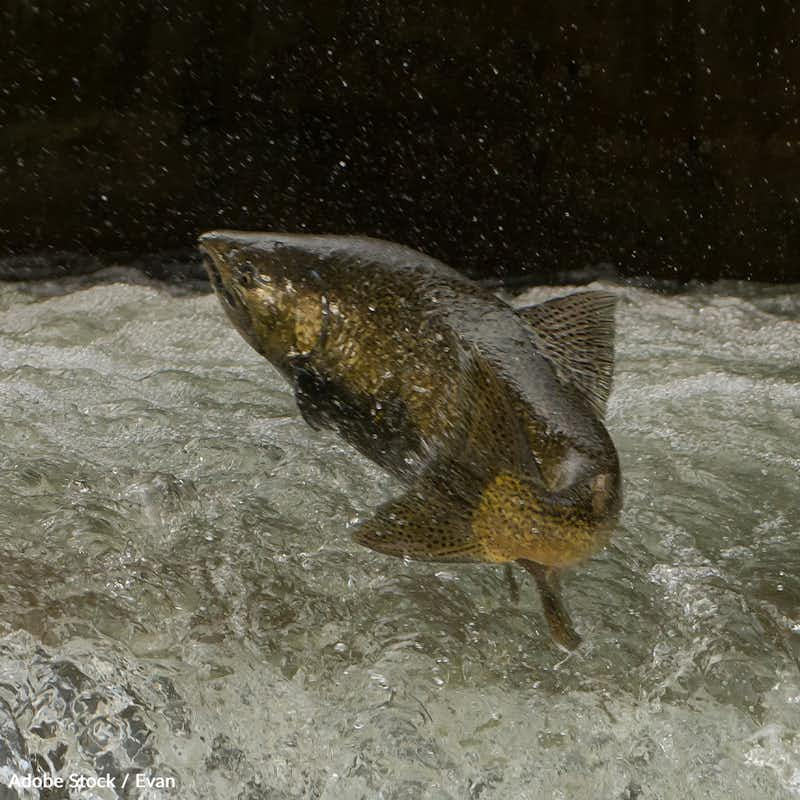Protect the Chinook Salmon and Its Ecosystem
6,380 signatures toward our 30,000 Goal
Sponsor: The Rainforest Site
Chinook salmon are dwindling because of overfishing and drought. Help us protect this magnificent fish species and the ecosystem it thrives in.

Join us in the fight to save Chinook salmon from extinction!
The Pacific Fishery Management Council has recommended a ban on Chinook salmon fishing off the California coast, and it needs approval from the National Marine Fisheries Service by May 161. We are asking you to pledge your support for the protection of this magnificent fish species and the ecosystem that it thrives in.
Chinook salmon is the largest Pacific salmon species, and its population is declining due to a variety of threats, including overfishing, habitat destruction, drought, heat waves, and agricultural activities2. These threats are not only detrimental to the survival of Chinook salmon but also impact the fishing industry that relies on it. This $1.4 billion industry provides employment to thousands, and with the temporary ban on commercial and recreational salmon fishing, the industry is expected to take a significant hit, affecting the livelihoods of many who depend on it3.
The impact of human activity on the water supply in California has been severe, leading to a loss of about 125 million acre-feet of groundwater (about 41 trillion gallons) from the Central Valley between 1920 and 20134. Due to unsustainable water management practices, fish populations are struggling to survive in degraded water conditions. The survival of salmon is contingent upon clean and cold water, particularly in rivers and streams where they migrate and spawn5. Nevertheless, the current extreme drought in California has resulted in a decrease in the availability of such water. Furthermore, farming and grazing activities that introduce sediments and chemicals into waterways have played a role in the reduction of fish populations.
Federal researchers have forecasted that fewer than 170,000 adult fall Chinook salmon could return to the Sacramento River this year, one of the lowest forecasts since 20086. Chinook salmon are declining in the Klamath River, too, as fewer than 104,000 are expected to arrive this season, the second lowest estimate since such research began in 19977. The Klamath River fall-run Chinook salmon was declared overfished in 2018, and the Sacramento River fall Chinook salmon is quickly approaching an overfished condition8.
In 2009, salmon fishing was halted in the region to help the population recover when about 122,200 adult fall Chinook salmon were forecast to return to the Sacramento River9. Now, about 23 out of the 31 genetically distinct kinds of salmon and trout in California are at risk of extinction sometime in the next century10.
We believe that every action counts, and we need your help in this fight. By signing our pledge, you are committing to supporting the protection and restoration of Chinook salmon and its habitat. You are joining a community of people who believe in the preservation of our natural world, its creatures, and its resources.
Take action now and sign our pledge to save Chinook salmon from extinction. Together, we can make a difference!
- Juliana Kim, NPR (7 April 2023), "California salmon fishing slated to shut down this year due to low stock."
- Pacific Fishery Management Council (2 February 2021), "Fact Sheet: Salmon."
- Golden State Salmon Association (2023), "The Problem."
- Nathan Halverson, Reveal (25 June 2015), "9 sobering facts about California’s groundwater problem."
- State of Salmon in Watersheds, "PRESSURE: Warming Temperatures Are Altering Salmon Streams."
- Elizabeth Weise, Dinah Voyles Pulver, USA TODAY (6 April 2023), "West Coast king salmon are so depleted officials just canceled the Oregon and California season."
- Ian James, Phys.org (3 March 2023), "Plummeting salmon population could trigger closure of fishing season in California waters."
- Pacific Fishery Management Council (4 April 2023), "Salmon Technical Team Report on the 2023 Klamath River Fall Chinook De Minimis Exploitation Rate."
- California Department of Fish and Wildlife (2023), "Chinook Salmon."
- Peter B Moyle, Robert A. Lusardi, Patrick Samuel, ResearchGate (2017 May), "State of the Salmonids II: Fish in Hot Water Status, threats, and solutions for California salmon, steelhead and trout.."
The Pledge:
As a concerned citizen, I pledge to take action to help save the salmon species from extinction in the United States. Salmon are a vital part of our ecosystem, providing essential nutrients for other wildlife and contributing to the health of our rivers and oceans. They also play a crucial role in the culture and economy of many coastal communities.
To help save salmon species from going extinct, I commit to taking the following actions:
- Reduce my carbon footprint by driving less, using public transportation, and making energy-efficient choices at home.
- Reduce my use of plastic by bringing my own reusable bags, water bottles, and containers.
- Conserve water by taking shorter showers, fixing leaks, and using water-efficient appliances.
- Plant trees and shrubs to provide shade and keep our waterways cool.
- Support sustainable fishing practices by purchasing wild-caught salmon from certified sustainable fisheries.
- Be intentional about making dietary choices that reduce demand for animal products that contribute to climate change and pollution.
- Advocate for stronger environmental policies and regulations to protect salmon habitat.
- Volunteer with local organizations that work to protect and restore salmon habitat.
- Educate others by sharing information about the importance of salmon and the actions we can take to help protect them.
- Donate to organizations working to protect and restore salmon habitat and populations, such as Project Peril, a program of Greater Good Charities, which partners with the best non-profits devoted to combating habitat loss, stopping the illegal wildlife trade, and preventing human-animal conflict.
By taking these actions, I hope to make a positive impact on the health and survival of salmon species in the United States.
Pledged by,